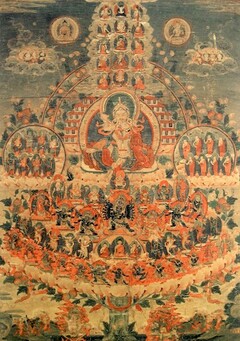Brief Explanation of Taking Refuge
Brief Explanation of Taking Refuge[1]
by Dodrupchen Jigme Tenpai Nyima
To you who, with non-referential compassion,
Protect beings of the infinite realms of existence,
Lord of Sages together with your heirs, I pay homage.
Let me succinctly present the principles of taking refuge.
This has five parts: 1) the objects of refuge, 2) its essence, 3) its literal meaning, 4) its divisons, and 5) the benefits of taking refuge.
1. The Objects of Refuge
As Introduction to the Bodhisattva's Way of Life indicates, there are three such objects:
Until I realize the essence of enlightenment,
I take refuge in the buddhas.
And likewise in the Dharma,
And the assembly of bodhisattvas.[2]
The first is the jewel of the Buddha, the ultimate source of refuge, who possesses the svabhāvikāya, which is the ultimate truth of cessation, and the wisdom dharmakāya, which is the ultimate truth of the path. Here, the svabhāvikakāya is the emptiness nature of the tathāgata’s wisdom, free from adventitious stains. Wisdom dharmakāya is the omniscience present within the continuum of a noble buddha’s enlightened mind. These themselves and the noble buddhas who possess such qualities constitute the jewel of the Buddha.
The jewel of the Dharma includes the two truths of cessation and the path. The wisdom in the enlightened continua of the noble ones is the true path, and these noble ones’ lack of any obscuration is true cessation. Such absence should also be understood as the noble ones’ higher emptiness that is free from stains.
The jewel of the Saṅgha includes noble beings such as the four types of noble one (ārya). Noble beings are those who have obtained uncontaminated wisdom. The four types of noble one include the trio of śrāvakas, pratyekabuddhas, and bodhisattvas, plus the noble buddhas. Alternatively it could refer only to the set of three noble ones.
2. The Essence of Refuge
The essence of refuge is to place great hope in the Three Jewels with the thought that they are one’s aids and protectors. This corresponds to the mental state of intention (cetanā; sems pa). By virtue of being accompanied by such an intention, all other mental states take on the same aspect.
3. Literal Meaning
Since the mind is drawn to and proceeds towards the Three Jewels as a refuge it is known as taking (or 'going for') refuge. This is akin to movement based on the intention to drink water. To put it simply, it means being drawn towards the objects of refuge through intention that is combined with hope.
4. Divisions
The two divisions are:
- Causal refuge-taking involves placing one’s hope in the Three Jewels that have manifest in others as aids and protectors who can bring freedom from the terrors of this and future lives.
- Resultant refuge-taking involves placing one’s hope in the resultant sources of refuge as attainable aids and protectors, with an attitude of seeking to manifest or attain the Three Jewels in one’s own mindstream.
5. Benefits
Taking refuge in the Three Jewels brings the immediate benefits of the qualities of the higher realms, such as longevity, closing the door to the lower realms, and so on. Ultimately it establishes the foundation for the qualities of definitive goodness.
This distilled account of taking refuge,
Expressed in concise and simple form,
Was written by the foolish youth called Jigme
At the behest of one named Losal Wangdrak.
May virtue abound!
| Translated by Adam Pearcey, 2022.
Bibliography
Tibetan Edition Used
'jigs med bstan pa'i nyi ma. rdo grub chen ’jigs med bstan pa’i nyi ma’i gsung 'bum. 7 vols. Chengdu: Si khron mi rigs dpe skrun khang, 2003. (BDRC W25007). Vol. 7: 231–234
Version: 1.0-20220817
